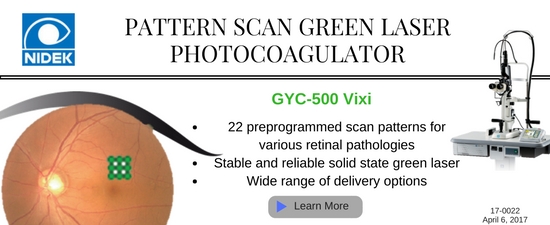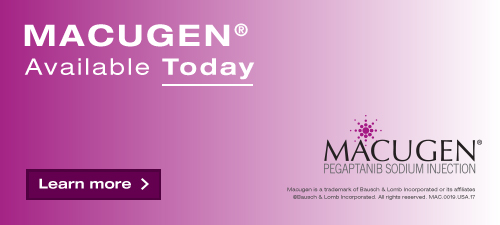
Volume 13, Number 4 |
April 2017 |

WELCOME to Review
of Ophthalmology's Retina
Online e-newsletter. Each month, Medical Editor Philip Rosenfeld, MD, PhD, and our editors provide you with this timely and easily accessible report to keep you up to date on important information affecting the care of patients with vitreoretinal disease. |

|
Serious Adverse Events With Bevacizumab or Ranibizumab for AMD
Researchers compared ranibizumab and bevacizumab for incidence of systemic serious adverse events among individuals with neovascular age-related macular degeneration, as part of a randomized trial. Use of individual data, rather than aggregate data, enabled adjustment for strong SAE predictors.
Researchers used the results of a Cochrane aggregate meta-analysis on the relative efficacy and safety of bevacizumab and ranibizumab—which included searches of bibliographic databases and clinical trial registries as of March 14, 2014—to identify six multicenter clinical trials. Individual patient data on SAEs, assigned drug and dosing regimens, and baseline prognostic factors were solicited from the six trial leaders. A two-stage approach helped estimate relative risks, and confidence intervals from Cox proportional hazards models adjusted for baseline prognostic factors. The primary outcome measure was development of ≥1 SAE; secondary outcome measures were death, arteriothrombotic events, events associated (and events not associated) with systemic anti-VEGF therapy.
Individual data from five trials offered information on 3,052 individuals, with no large imbalances between drug groups on baseline factors. The adjusted relative risks and CIs for bevacizumab relative to ranibizumab were 1.06 (CI 0.84 to 1.35; p=0.61) for ≥1 SAE. For secondary outcomes, adjusted relative risks were 0.99 (CI 0.69 to 1.43; p=0.97) for death; 0.89 (CI 0.62 to 1.28; p=0.53) for arteriothrombotic events; 1.10 (CI 0.81 to 1.50; p=0.54) for events related to anti-VEGF treatment; and 1.11 (CI 0.87 to 1.40; p=0.40) for events not related to anti-VEGF treatment.
Researchers concluded that findings supported few differences in risk of systemic SAEs between the two anti-VEGF drugs (i.e., relative risks of ≥1.5 were unlikely). They wrote further that additional head-to-head trials were unlikely, so further investigation of differential risk between anti-VEGF agents likely would be achieved through postmarketing surveillance or investigation of health-care databases.
SOURCE: Maguire MG, Shaffer J, Ying G-S, et al. Serious adverse events with bevacizumab or ranibizumab for age-related macular degeneration: meta-analysis of individual patient data. Ophthalmology Retina 2017; Apr. 12. [Epub ahead of print].
VA Improvement Not Sustained After Switch From Ranibizumab to Aflibercept
Researchers assessed whether visual benefits could be found by switching to aflibercept in individuals chronically treated with ranibizumab for neovascular age-related macular degeneration.
They conducted a multicenter, electronic medical records database study, and matched individuals undergoing six continuous monthly ranibizumab injections who were then switched to continuous aflibercept, to those on continuous ranibizumab therapy. Matching was performed in a 2:1 ratio and based on VA six months before and at the time of the switch, and the number of previous ranibizumab injections.
Individuals switched to aflibercept demonstrated transiently significant improvement in VA that peaked at an increase of 0.9 Early Treatment Diabetic Retinopathy Study letters three months after the switch, whereas controls continued on ranibizumab showed a steady decline in VA. VA differences between the groups were significant (p<0.05) at two, three and five months after the switch. Beginning at four months after the switch, the switch group showed a VA decline similar to the control group.
Scientists wrote that transient, non-sustained VA improvement occurred when switching between anti-vascular endothelial growth factor agents, which they added might have implications for treating individuals on chronic maintenance therapy.
SOURCE: Lee CS, Kim AJ, Baughman D, et al. Visual acuity improvement when switching from ranibizumab to aflibercept is not sustained. Retina 2017; Apr. 11. [Epub ahead of print].
nAMD With PED: Factors Influencing Treatment Response
Investigators evaluated baseline and treatment factors influencing the response of pigment epithelial detachment in individuals with treatment-naive neovascular age-related macular degeneration after one year of intravitreal anti-vascular endothelial growth factor treatment, as part of a retrospective, consecutive case series.
The study included 104 eyes (94 individuals) with treatment-naive nAMD and associated PED>150 µm treated with aflibercept (n=41) or ranibizumab (n=63) for at least one year. Stepwise linear regression was used to assess factors influencing best-corrected visual acuity and PED response.
At one year, the best-corrected visual acuity improved from 20/63+1 (60.8 ±15.9 Early Treatment of Diabetic Retinopathy Study letters) at baseline to 20/40-1 (69 ±15 letters) (p=0.001), and PED maximal height decreased from 370.8 ±205.6 µm to 238.8 ±178.5 µm (p=0.001). Multivariate analysis revealed an association between visual improvement with lower BCVA at baseline (p=0.001), the presence of foveal subretinal fluid (p=0.001) and female gender (p=0.047). PED height reduction was dependent on higher baseline PED height (p=0.001) and treatment drug (p=0.008).
Investigators determined that visual improvement in nAMD with PED was equally achieved with ranibizumab and aflibercept, influenced mainly by baseline BCVA and foveal subretinal fluid. They also found that PED height reduction was influenced by baseline height and the treatment drug, favoring aflibercept for a stronger effect. However, they wrote that the clinical significance of this result warranted further studies.
SOURCE: de Massougnes S, Dirani A, Mantel I. Good visual outcome at 1 year in neovascular age-related macular degeneration with pigment epithelium detachment: Factors influencing the treatment response. Retina 2017; Mar 30. [Epub ahead of print].
Vascular Safety of Ranibizumab for Diabetic Macular Edema
Individuals with diabetic macular edema are at high risk of vascular complications, including stroke and myocardial infarction, researchers wrote. Concerns have been raised that intravitreal dosing of vascular endothelial growth factor inhibitors in DME could be associated with an increase in cardiovascular and cerebrovascular adverse events, they added. As such, the researchers evaluated the cardiovascular and cerebrovascular safety of ranibizumab 0.5 mg and 0.3 mg, compared with sham, with and without laser in DME. Several of the researchers are employees of Novartis or Genentech.
They included data from six randomized, double-masked, sham- and laser-controlled clinical trials and company-sponsored (Genentech or Novartis) studies in DME completed as of December 31, 2013. They performed pairwise comparisons (ranibizumab 0.5 mg vs. sham and laser; ranibizumab 0.3 mg vs. sham) using Cox proportional hazard regression (hazard ratios, CIs) and rates per 100 person-years. Data analysis was conducted from June 1 to July 15, 2015.
Researchers prospectively defined Standardized Medical Dictionary for Regulatory Activities queries and extended searches to identify relevant safety end points, including arterial thromboembolic events, MI, stroke or transient ischemic attack, vascular deaths and major vascular events as defined by the Antiplatelet Trialists' Collaboration.
Overall, 936 individuals were treated with ranibizumab 0.5 mg, 250 with ranibizumab 0.3 mg and 581 with sham/laser. The hazard ratios associated with all pairwise comparisons included one for all key cardiovascular and cerebrovascular safety end points.
Hazard ratios were:
• for arterial thromboembolic events: 1.05 (CI, 0.66 to 1.68) for ranibizumab 0.5 mg vs. sham/laser, and 0.78 (CI, 0.43 to 1.40) for ranibizumab 0.3 mg vs. sham;
• for MI: 0.84 (CI, 0.41 to 1.72) for ranibizumab 0.5 mg vs. sham/laser, and 0.94 (CI, 0.43 to 2.06) for ranibizumab 0.3 mg vs. sham;
• for stroke or transient ischemic attack: 0.94 (CI, 0.44 to 1.99) for ranibizumab 0.5 mg vs. sham/laser, and 0.53 (CI, 0.19 to 1.42) for ranibizumab 0.3 mg vs. sham;
• for stroke (excluding transient ischemic attack): 1.63 (CI, 0.65 to 4.07) for ranibizumab 0.5 mg vs. sham/laser, and 0.59 (CI, 0.14 to 2.46) for ranibizumab 0.3 mg vs. sham;
• for vascular death: 2.17 (CI, 0.57 to 8.29) for ranibizumab 0.5 mg vs. sham/laser, and 2.51 (CI, 0.49 to 12.94) for ranibizumab 0.3 mg vs. sham; and
• for APTC-defined events: 1.09 (CI, 0.63 to 1.88) for ranibizumab 0.5 mg vs. sham/laser, and 1.00 (CI, 0.51 to 1.96) for ranibizumab 0.3 mg vs. sham.
This pooled analysis included one of the largest patient-level data sets on treatment of DME with ranibizumab, according to researchers. They wrote that, although findings weren’t equipped to detect small differences for infrequent events such as strokes, they suggested that intravitreous ranibizumab didn’t increase the risk of systemic vascular events. However, they added that uncertainty remained for individuals with DME at high risk for vascular disease, who were not included in these trials.
SOURCE: Zarbin MA, Dunger-Baldauf C, Haskova Z, et al. Vascular safety of ranibizumab in patients with diabetic macular edema: A pooled analysis of patient-level data from randomized clinical trials. JAMA Ophthalmol 2017; Apr 6. [Epub ahead of print].
OCT Retinal Features’ Predictive Value for Bevacizumab and Ranibizumab for DME
Scientists established the predictive value of specific optical coherence tomography retinal features on visual outcomes and retinal thickness during anti-vascular endothelial growth factor treatments in individuals with diabetic macular edema.
They analyzed post hoc analyses of compound data from a prospective, six-month, multicenter, randomized controlled trial of 119 individuals with DME receiving either intravitreal bevacizumab or ranibizumab to assess associations between baseline retinal morphologic parameters, and change in best-corrected visual acuity and central subfield thickness. Based on the study protocol, BCVA and central subfield thickness were obtained before each mandatory monthly injection over six months.
Presence of serous retinal detachment at baseline was associated with significant improvement in BCVA letter score at month three (p<0.001) and month six (p=0.01). In addition, presence of disorganization of retinal inner layers was associated with lower BCVA letter score at month three (p<0.05) and month six (p=0.01).
Scientists determined that serous retinal detachment and disorganization of retinal inner layers were associated with different treatment responses to anti-vascular endothelial growth factor therapy in individuals with DME.
SOURCE: Fickweiler W, Schauwvlieghe A-SME, Schlingemann RO, et al. Predictive value of optical coherence tomographic features in the Bevacizumab and Ranibizumab in patients with Diabetic Macular Edema (BRDME) study. Retina 2017; Apr 11. [Epub ahead of print].
Intravitreal Bevacizumab Alone or Combined With Triamcinolone in DME
Researchers compared the results of intravitreal bevacizumab injection alone or in combination with intravitreal 1 mg triamcinolone acetonide in center-involved diabetic macular edema.
This randomized clinical trial included 92 eyes of 46 individuals with bilateral, center-involved diabetic macular edema and no previous treatment. Researchers randomly assigned one eye of each person to 1.25 mg of IVB injection, or combination of 1.25-mg IVB and 1-mg IVT. Evaluation of best-corrected visual acuity, central macular thickness, intraocular pressure and grading of lens opacity was conducted at baseline, and weeks two, four, six, eight, 12 and 24 after treatment. Retreatment was performed at a six-week interval whenever indicated based on CMT.
Between the groups, BCVA changes were not statistically different until the 24-week follow-up (p>0.05). At 24 weeks after treatment, BCVA improvement was significantly better in the IVB group (p=0.049). Researchers observed significant CMT reduction in each group along the follow-up period (p=0.001). The mean CMT reduction was more significant in the combination group at the two-week follow-up (p<0.001), but CMT changes were not significant between the groups at weeks 12 and 24 after injection. Overall, retreatment was applied for 59 eyes up to 24 weeks (33 in the IVB group, 26 in the combination group). Among individuals with two or more injections, the number of injections was significantly lower in the combination group (p=0.043). Three eyes within the combination group developed IOP elevation beyond 21 mmHg, which was controlled with topical anti-glaucoma medications within one week. Changes in lens opacity were not significant between the two groups.
Researchers determined that eyes treated with IVB plus 1-mg IVT had more significant reductions in CMT in the early post-injection period, although the effect was transient. Though VA improvement was better in the IVB group after 24 weeks, researchers suggested that combination therapy might decrease the number of injections. They added that combining 1 mg of intravitreal triamcinolone with bevacizumab didn’t yield significant side effects.
SOURCE: Riazi-Esfahani M, Riazi-Esfahani H, Ahmadraji A, et al. Intravitreal bevacizumab alone or combined with 1 mg triamcinolone in diabetic macular edema: A randomized clinical trial. Int Ophthalmol 2017; Mar 27. [Epub ahead of print].

Predictive Factors for Bilateral Vitrectomy in Proliferative DR
Scientists investigated predictive factors for visual outcomes in the second operated eye of individuals undergoing bilateral vitrectomy for proliferative diabetic retinopathy.
They retrospectively examined the clinical records of 55 individuals undergoing bilateral vitrectomy for proliferative diabetic retinopathy at the University Eye Hospital Ljubljana (Slovenia) between January 2009 and December 2014. They performed statistical analyses to identify variables associated with good visual outcomes.
The mean preoperative visual acuity was 6/181 Snellen (1.48 ±0.47 logMAR). The follow-up period after vitrectomy was at least one year, and mean postoperative visual acuity improved to 6/31 Snellen (0.71 ±0.62 logMAR). On univariate analysis, variables predicting good postoperative vision (6/12 Snellen or better) were the following: absence of macular detachment (p=0.009); previously performed full panretinal laser (p=0.03); and good vision in the previously vitrectomized fellow eye (p<0.001). On multivariate analysis, the absence of macular detachment (p=0.001) and good vision in the previously vitrectomized fellow eye (p<0.001) were independently associated with good visual outcome.
Scientists found that, in individuals undergoing second-eye vitrectomy for complications of proliferative DR, the VA of previously operated fellow eyes and the presence of macular detachment in the eye due for vitrectomy might be strong independent predicting factors for visual outcome.
SOURCE: Sulak M, Urbancic M, Petrovic MG, et al. Predicting visual outcomes of second eye vitrectomy for proliferative diabetic retinopathy. Retina 2017; Mar 22. [Epub ahead of print].

GCIPL Thickness in DME Via SD-OCT
Investigators wrote that reduced thickness of the ganglion cell inner plexiform layer, which can indicate diabetic neurodegeneration, may be assessed by spectral-domain optical coherence tomography. They compared GCIPL measurements in diabetic macular edema cases, using two SD-OCT devices.
Investigators included analyses of OCT data sets of eyes with DME and fellow eyes without DME. They also compared macular cube scans of sufficient signal strength on Cirrus (Carl Zeiss Meditec) with correlating scans on Spectralis (Heidelberg Engineering), acquired within one hour.
Eighty-one equivalent data sets for 20 eyes with DME (20 individuals; six females) and 33 for nine fellow eyes without DME (nine individuals; two females) were included from each device. In DME eyes, mean GCIPL thicknesses were 62.5 ±20.4 µm on Cirrus and 91.2 ±9.3 µm on Spectralis. GCIPL was significantly thicker on Spectralis analyses of eyes with and without signs of DME (p<0.001). The GCIPL variance (54.2 percent) related to device differences decreased to 34.8 percent in eyes without DME.
Investigators found that GCIPL data from different devices varied considerably and shouldn’t be used interchangeably. Although they wrote that SD-OCT was indispensable for identifying ganglion cell loss associated with diabetic neurodegeneration, they suggested that clinicians should be aware of device differences when monitoring individuals.
SOURCE: Hafner J, Prager S, Lammer J, et al. Comparison of ganglion cell inner plexiform layer thickness by Cirrus and Spectralis optical coherence tomography in diabetic macular edema. Retina 2017; Apr 3. [Epub ahead of print].

Ranibizumab Injection as Primary ROP Treatment
Researchers assessed the anatomic outcomes and influencing factors of ranibizumab in treatment of retinopathy of prematurity, as part of a retrospective case series. A total of 283 eyes of 145 infants with type 1 ROP treated with intravitreal injection of ranibizumab as the primary treatment were included.
Researchers retrospectively reviewed cases of infants diagnosed with type 1 ROP accepting IVR (0.25 mg/0.025 ml) as primary treatment from January 2012 to August 2015. They analyzed anatomic outcomes and influencing factors. Main outcome measures included anatomic outcomes of ROP eyes after IVR and influencing factors.
A total of 283 eyes of 145 cases were included, with a total of 266 eyes (94 percent) in the positive response group and 17 eyes (6 percent) in the negative/no response group after IVR. Within the positive response group, 139 eyes (48.6 percent) were in the regression without reactivation subgroup, and 127 eyes (44.9 percent) were in the regression with reactivation subgroup. A total of 152 eyes received additional laser or surgical treatment. At the last visit, 278 eyes (98.2 percent) had attached retinas, and five eyes (1.8 percent) had retinal detachment. A classification tree model showed that, for individuals with gestational age (GA) ≤29.5 weeks, the possibility of experiencing reactivation after IVR was higher than that of those with GA >29.5 weeks (61.6 percent vs. 29.6 percent). Moreover, for individuals with GA ≤29.5 weeks, those diagnosed with zone II stage 2+ ROP had a lower possibility of experiencing reactivation than other individuals (37.9 percent vs. 80 percent).
Researchers found that intravitreal injection of ranibizumab seemed to be effective in treating ROP cases and noted primarily three different outcomes after treatment. They suggested their predictive tree model might be helpful for ophthalmologists to evaluate risk of reactivation.
SOURCE: Huang Q, Zhang Q, Fei P, et al. Ranibizumab injection as primary treatment in patients with retinopathy of prematurity. Ophthalmology 2017; April 13. [Epub ahead of print].

Whole-Exome Sequencing Identifies Biallelic IDH3A Variants as Cause of RP With Pseudocoloboma
Investigators identified the genetic cause of, and described, the phenotype in four families with autosomal recessive retinitis pigmentosa sometimes associated with pseudocoloboma, as part of a case series.
Investigators performed homozygosity mapping and whole-exome sequencing in five probands and two unaffected family members from four unrelated families. Subsequently, they performed Sanger sequencing and segregation analyses in additional family members. They also reviewed the medical history of individuals carrying IDH3A variants and performed additional ophthalmic exams, including full-field electroretinography, fundus photography, fundus autofluorescence imaging and optical coherence tomography.
Main outcome measures included IDH3A variants, age at diagnosis, visual acuity, fundus appearance and visual fields along with full-field electroretinography, fundus autofluorescence and optical coherence tomography findings.
Investigators identified seven variants in IDH3A in four unrelated families, i.e., five missense, one nonsense and one frameshift variant. All participants showed symptoms early in life, ranging from night blindness to decreased VA, and were diagnosed between the ages of 1 and 11 years. Four participants with biallelic IDH3A variants displayed a typical arRP phenotype, and three participants were diagnosed with arRP and pseudocoloboma of the macula.
IDH3A variants were identified as a novel cause of typical arRP in some individuals associated with macular pseudocoloboma. Investigators observed both phenotypes in two siblings carrying the same compound heterozygous variants, which they wrote could be explained by variable disease expression; they cautioned readers not to make assertions about genotype-phenotype correlations based on the findings.
SOURCE: Pierrache LHM, Kimchi A, Ratnapriya R, et al. Whole-exome sequencing identifies biallelic IDH3A variants as a cause of retinitis pigmentosa accompanied by pseudocoloboma. Ophthalmology 2017; April 13. [Epub ahead of print].

Preferred Retinal Location & Transition Zone in Stargardt Disease
Scientists considered morpho-functional features of the preferred retinal location and transition zone in a series of cases with recessive Stargardt disease.
A total of 52 individuals with STGD1 with at least one ABCA4 mutation, atrophy of the central macula and an eccentric PRL were recruited for the study. Microperimetry, fundus autofluorescence and spectral-domain optical coherence tomography were performed. Scientists determined PRL location and stability along with associated FAF patterns and visual sensitivities, and compared them to the underlying retinal structure.
The mean visual sensitivity of the PRLs for the 52 eyes was 10.76 ±3.70 dB. For the majority of eyes, PRLs were associated with intact ellipsoid zone bands and qualitatively normal FAF patterns. In 17 eyes (32.7 percent), the eccentric PRL was located at the edge of the central macula. In 35 eyes (67.3 percent) it was located at varying distances from the border of the central macula, with a TZ between the PRL and the macula. The TZ was associated with decreased sensitivity values (5.92 ±4.69 dB) compared with PRLs (p<0.05), with absence/disruption of the EZ band and abnormal FAF patterns (hyper- or hypo-autofluorescence).
In STGD1, eccentric PRLs were located away from the border of the central macula, and associated with intact EZ bands and normal FAF findings. The TZ was characterized by structural and functional abnormalities. Scientists wrote that results of multimodal imaging of the PRL and TZ indicated a possible sequence of retinal and functional changes with disease progression that may help in the planning of future therapies. They wrote further that RPE dysfunction appeared to be the primary event leading to photoreceptor degeneration and RPE loss.
SOURCE: Verdina T, Greenstein VC, Sodi A, et al. Multimodal analysis of the preferred retinal location and the transition zone in patients with Stargardt disease. Graefes Arch Clin Exp Ophthalmol 2017; Apr 2. [Epub ahead of print].

|




